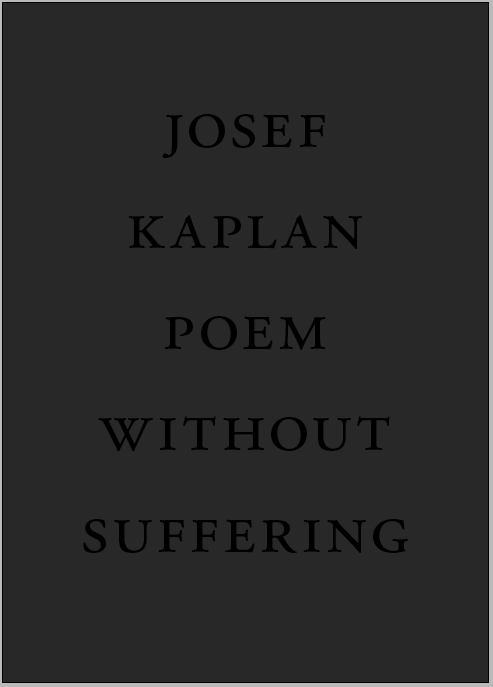
Poem Without Suffering by Josef Kaplan
a review by Dale Enggass
Wonder
2016
96 pages
$13.95
No Background: On Josef Kaplan’s Epic Similes
In a famous essay on the Homeric style, “Odysseus’ Scar,” Erich Auerbach argues that Homeric digressions, epithets, and similes do not establish a “subjectivistic-perspectivistic” creation of a “foreground and background…[that would result] in the present lying open to the depths of the past” (7). All such seeming deviations from the present narrative (including the story of how Odysseus got that scar while hunting wild boar) are in fact just another present in the world of the poem. The Homeric style, according to Auerbach, “represent[s] phenomena in a fully externalized form”; there is no suspense, no background. Homer is all foreground (6). While it would be easy to critique Auerbach’s absolute separation of the “closed” world of ancient literature from more “modern” forms, and argue that the Odyssey is a much cannier poem than he gives it credit for, I raise this admittedly dated example because I sense a similar exhaustive externalization of phenomena in Josef Kaplan’s astonishing Poem Without Suffering (Wonder Books: 2015). Ostensibly attending to the minute but inconceivably rapid trajectory of a bullet passing through a human head, Kaplan’s poem is an equally unstoppable force, and updates the Epic tradition for our current hyperlinked, hyperactive, hyperviolent age.
Or, to state it bluntly: Poem Without Suffering is an approximately 2,025-line epic poem about kids being shot in the head. Stating it thus partakes in the poem’s own simultaneously objective, declarative style, and knowing, winking awareness of how any such claims to objectivity are constantly undermined by the excess of its language. While Poem in many ways represents a turn in Kaplan’s work, he has toyed with such tonal ambiguity before. His previous project Kill List (published by Cars Are Real in 2013), listed the names of a wide range of contemporary poets followed by either “is a rich poet” or “is a comfortable poet.” It caused something of a stir (at least in the small world of North American avant-garde poetry), in no small part because of its title—but also because of the anxiety it provoked with its flatly asserted yet ambiguous take on the fraught relationship between poets and money (and proving in the process that there really is no such thing as a “comfortable poet,” at least when it comes to self-image).
Poem Without Suffering is a very different project, but it too engages the rhetoric of violence, and employs an ambiguous tone built on a seemingly objective approach to content usually treated as highly emotional. The poem—nestled enigmatically between its black covers, with title and author barely legible in even darker lettering, and not freighted with any paratextual baggage such as blurbs, author bios, notes, acknowledgements and the like—opens mid-stream with a desire “To have it happen, / but to have it not / be considered / tragedy…” (3). What “it” is is not immediately clear, but the poetic voice hopes “it creates / no suffering, at least / not in the moment / that it happens, / and at least not / for the children. / They don’t suffer” (3-4). “It,” it turns out, is “this moment, / when a jacketed / hollow-point bullet” enters the head of one these children and proceeds to blast its way through layers of flesh, tissue, and skull. The poem is driven by the tensions inherent to “this moment,” which is both the instant of death and, paradoxically, a continual deferral of finality.
This deferral is accomplished through a series of extended digressions that quickly overwhelm and explode the poem’s “present.” These digressions often take the form of elaborate similes (epic similes, let’s call them) that serve to vividly describe the bullet’s path of destruction even as they continually retard its progress. For instance, the lack of suffering in the moment of death is contrasted with “the fear that / we might, after our / expiration, appear / dead in every way / … when / we are in fact not dead” (4); this uncanny consciousness of and beyond one’s death is (after some 70 lines of brilliant elaboration) finally rejected (“But this is not death”) because
Death, as we imagine it,
is an end to suffering,
an edge across which
the fine caul of pain
that passes always
over the touch and
whisper of life
suddenly
disintegrates
and is gone,
like in this moment,
when a jacketed
hollow-point bullet…(17)
I quote at greater length here in order to give a feel for the poem’s propulsive movement, driven by its short, clause-length lines, and Kaplan’s excellent use of enjambment, which makes the poem hard to put down (and even harder to quote effectively!). Momentum is also generated by the Russian-doll like construction of the simile: the purported focus of the poem, “this moment” in which a bullet passes through a child’s head, is itself a simile (“like in this moment”) that is meant to exemplify the instant of death. From its start, the poem is overtaken by its nested series of digressions, an epic comprised only of its similes.
Indeed, I had to break off the above quotation or else risk reproducing the meticulous description of the bullet (“sized approximately / 0.224 inches (or / 5.7 millimeters) / at its diameter / and housed in a 5.56 millimeter / by 45 millimeter / cartridge” (7-8)) that appears before the conclusion of the clause beginning “when.” And, let’s be honest, I’m still drastically simplifying things, because this digression within a digression also contains further digressions concerning the bullet’s weight, its proper designation (“a .223 Remington / cartridge, pronounced / either ‘two-two- / three’ or ‘two- / twenty-three’”), and its similarity to NATO’s cartridge of choice, among other discursive detours.
Of course, deferral is exactly what epic similes do not accomplish in Auerbach’s analysis—and here is where Poem Without Suffering neatly collapses epic similes with our age of distraction. As in the above example, the poem at times seems to mimic, or perhaps to actually reproduce, passages from Wikipedia pages and their signature pseudo-objective presentation of “facts.” And like Wikipedia and related online info dumps, the poem’s digressions include a range of registers that are not mutually exclusive: scientific, gruesome, absurd, or hilarious, as when the poem compares a bullet passing through layers of tissue to “a determined / but considerate / pedestrian / who has suddenly / come upon a / crowd,” after which the verse gets stuck in an obsessive groove of some 75 lines that repeat various ways of saying “excuse me” (12).
These textual rabbit holes enact our current moment’s thorough colonization by the logic of the Internet: a Google search of, say, “Columbine Shooting” or “Sandy Hook” could ultimately lead one to a history of the video game Doom or the current price for a Samurai sword. Numerous particles of information exist now on the same perpetually expanding plane (or at least appear to). In other words: the Internet is all foreground. Yet even as the poem points to this apparent leveling of informational hierarchies, its spiraling similes work to question their own efficacy, as when the bullet’s force is compared to the unprecedented athletic achievements of “Someone / like Usain Bolt, / whose last name / recalls the term used / to describe the / ammunition fitted / to a crossbow…/ which prefigures / the notion of a bullet” (24). This analogy to the Olympic 100 meter world record-holder (which is, of course, expanded upon in great detail) demonstrates Kaplan’s ability to mess with tone, as well as the way such tonal shifts are redolent of the Internet’s horizontal presentation of knowledge, while also managing to question whether such analogies are as random as they might initially seem. That is, by a certain logic, the conjunction of common noun, proper noun, and verb in “Bolt” “prefigures / the notion of a bullet.” The simile is both excessive and apt, particularly given the poem’s fascination with speed as a comparative measure of thought, narrative, and objects.
The poem’s ambivalence about the functioning of its similes is further established by a “not that, but this” pattern, in which many similes are negated after they have been exhaustively developed (c.f. “But this is not death,” above). This structure of elaboration followed by negation culminates, in the poem’s closing lines, with a death that morphs into a birth (and vice versa; note the careful choice of the word “caul” in the extended passage above). The similes thus function not only as digression but also as (in yet another simile) “two reels of film / projected one over / the other, the same / film, one reel playing forwards, the other in reverse” (85).
The poem’s complex of simultaneity and digression ultimately activates an uncomfortable ambiguity in the reader. To paraphrase Freud, a child is being shot; and yet, Kaplan’s poem is often quite funny in how it smothers itself in its exhaustive lists and descriptions. What is one to do? Laugh? Cry? Or keep calm and scroll on? As should be clear by now, Poem Without Suffering is emphatically not interested in shooters, victim(s), blame, gun policy, trauma, grief, bullying, childhood innocence, or any of the other topics that a poem published in America in 2015 in which children are shot could conceivably take an interest in. And this is precisely what makes it so compelling. While it hints at many of these topics, and, indeed, forces the reader to visualize in excruciatingly visceral detail the effects of mechanized violence on the human body, its tonal shifts keep the reader continuously off balance. Poem Without Suffering accomplishes its power by refusing to position itself on a stable ground from which it can make absolute moral pronouncements (that could then be simply agreed or disagreed with). Instead, it shoots us right into the middle of the mess.
